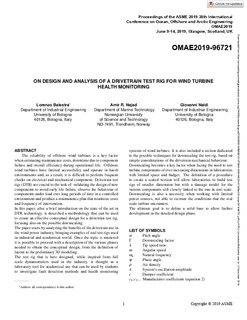| dc.description.abstract | The reliability of offshore wind turbines is a key factor when estimating maintanence costs, downtime due to component failure and overall efficiency during operational life. Offshore wind turbines have limited accessibility and operate in harsh environments and, as a result, it is difficult to perform frequent checks on electrical and mechanical component. Drivetrain test rigs (DTR) are crucial to the task of: validating the design of new components to avoid early life failure, observe the behaviour of components under load over long periods of time in a controlled environment and produce a maintanence plan that minimize costs and frequency of intervention. In this paper, after a brief introduction on the state of the art in DTR technology, is described a methodology that can be used to create an effective conceptual design for a drivetrain test rig, focusing also on the possible downscaling. The paper starts by analyzing the benefits of the drivetrain use in the wind power industry, bringing examples of real test rigs used in industrial and academical world. Once the topic is mastered it is possible to proceed with a description of the various phases needed to obtain the conceptual design, from the definition of layout to the preliminary 3D modeling. The test rig that is here designed, while inspired from full scale dynamometers used in the industry, is thought as a laboratory tool for academical use that can be used by students to investigate fault detection methods and health monitoring systems of wind turbines. It is also included a section dedicated to the possible techniques for downscaling the test rig, based on simple considerations of the drivetrain mechanical behaviour. Downscaling becomes a key factor when facing the need to test turbine components of ever increasing dimensions in laboratories with limited space and budget. The definition of a procedure to create a scaled version will allow laboratories to build test rigs of smaller dimension but with a damage model for the various components still closely linked to the one in real scale. Downscaling is also a necessity when working with limited power sources, not able to recreate the conditions that the real scale turbine encounters. The ultimate goal is to define a solid base to allow further development in the detailed design phase. | nb_NO |
